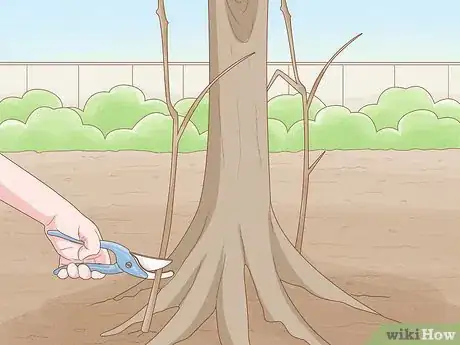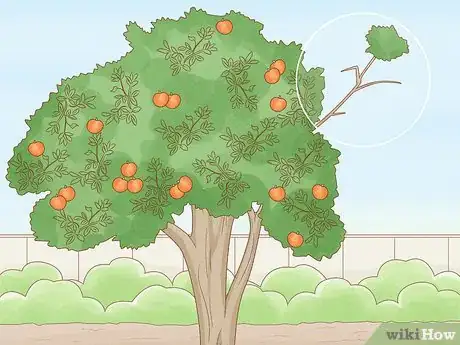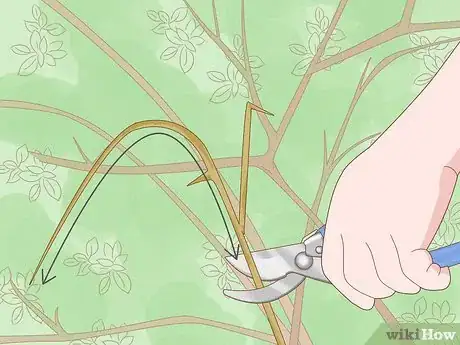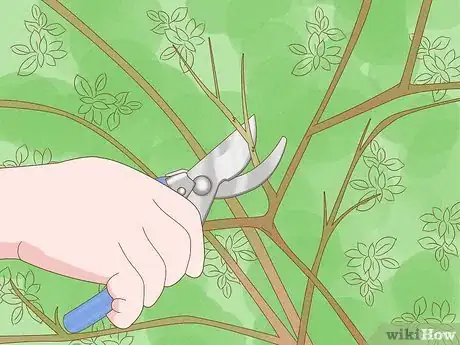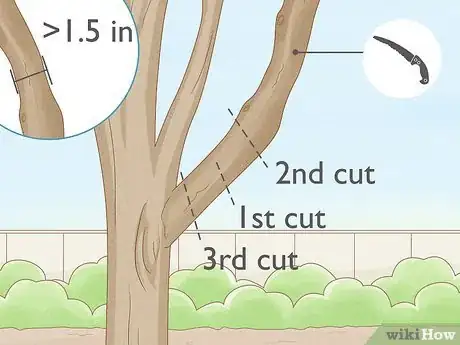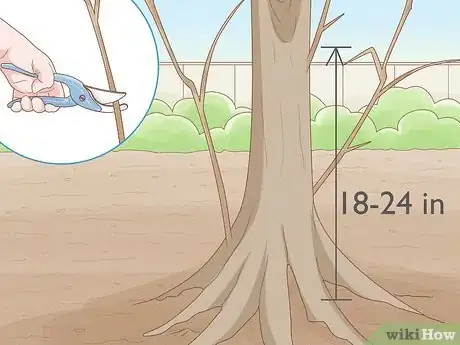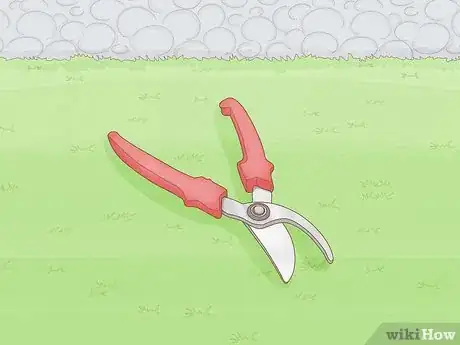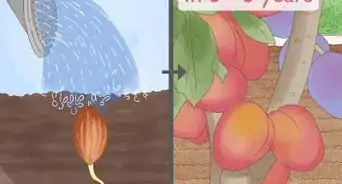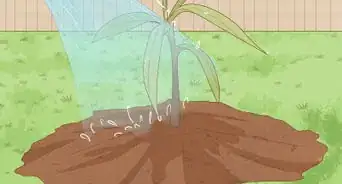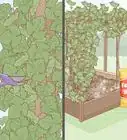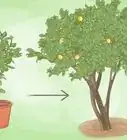This article was co-authored by Monique Capanelli. Monique Capanelli is a Plant Specialist and the Owner and Designer for Articulture Designs, an innovative design firm and boutique in Austin, Texas. With over 15 years of experience, Monique specializes in interior botanical design, living walls, event decor, and sustainable landscape design. She attended the University of Texas at Austin. Monique is a Certified Permaculture Designer. She provides plant and botanical design experiences, from small gifts to entire transformations, to shoppers as well as commercial clients including Whole Foods Market and The Four Seasons.
There are 12 references cited in this article, which can be found at the bottom of the page.
This article has been viewed 13,028 times.
Pruning is a part of regular plant care, but it's not always super clear how to do it properly and trees tend to have different needs. Luckily, satsuma trees are pretty easy to care for and they don’t need much pruning at all. A seasonal clipping to keep things tidy and some easy maintenance stuff throughout the year should do the trick! With the right pruning practices, you’ll ensure that your tree stays healthy and keeps producing delicious citrus fruits.
Steps
Year-Round Maintenance
-
1Prune small branches at any time to keep the tree neat. It’s okay to prune these branches throughout the year, including during the winter. If any small branches are growing out of place or looking dry, then clip them off as soon as you see them.[1]
- Don’t cut any branches larger than 1⁄2 in (1.3 cm) in diameter in the winter to avoid damaging the tree.[2]
- Young Satsuma trees generally don't need any pruning. Trees that are a few years old need some basic maintenance to stay healthy, but usually don't need heavy pruning.
-
2Cut small branches or sprouts right before they reach the trunk. Cutting the branch right where it meets the trunk usually makes a bigger wound, since this is a thicker part of the branch. Instead, no matter what kind of branch you’re pruning, clip it at the thinner point right before it reaches the trunk.[3]
- This might not always be true, so use your judgment and clip in the spot that will leave the smallest wound.
- For some very thick branches, you may need a pruning saw instead. This is more common for older, larger trees.[4]
Advertisement -
3Get rid of any branches that grow beyond the tree’s natural shape. This is a cosmetic change rather than one that keeps the tree healthy.[5] If some branches are growing out too far and throwing off the tree’s shape, then it’s fine to trim them back so they fit in with all the others.[6]
- This is totally optional, and you can let the tree grow into any shape it wants to if you prefer.
-
4Clip any small branches that press against other ones. Satsuma trees sometimes spout cross branches that poke at other branches or grow back into the trunk. Clip these off so they don’t damage the other branches.[7]
- These branches are usually pretty small, so you can do this at any time of year. If they’re more than 1⁄2 in (1.3 cm) thick, wait until the spring to cut them.
-
5Prune drooping branches to make them straight. Satsuma branches often grow straight up, but some of them will start drooping after carrying fruit. In this case, find the point where the branch starts to bend down. Cut it right before that, closer to the trunk, so the new branch will grow up again.[8]
- If an entire branch is pointing down, then it’s fine to prune the whole thing.
-
6Remove dead or diseased branches quickly to prevent spreading. Satsumas are susceptible to some diseases and fungi, and these infections could infect the whole tree if you don't take action quickly. As soon as you see any branches that look dead or diseased, cut them off entirely to stop the infection from spreading.[9]
- Common signs of disease include browning leaves, leaves falling off, dark blotches or lesions on the branch and leaves, and discoloration of the branch.[10]
- You can remove diseased branches at any time, even if they're large. It's not ideal to leave a large wound on the tree during the off-season, but it's better than letting the infection overtake the tree.
- If you remove any diseased limbs, be sure to disinfect your pruners with bleach or alcohol before using them again. Otherwise, you could spread the infection to other plants.[11]
Major Pruning
-
1Wait until early spring to remove large branches. This is the ideal time because there is no more risk of winter frost, but it’s before the satsuma growing season. This means that the tree can adjust its resources before growing any fruit.[12]
- Blooms usually start appearing in April, so slightly before this is the best time to prune.[13]
- Late-season pruning, like in the fall, is not a good idea because the wounds might not be fully healed before winter starts.
-
2Use a three-part cut for branches thicker than 1.5 in (3.8 cm). This is a technique to prevent the bark from tearing. Start by cutting 1/3 through the branch from the bottom, about 6–12 in (15–30 cm) from the trunk. Then cut completely through the branch about 3 in (7.6 cm) further out from that cut. Finally, cut the remaining nub where it meets the trunk.[14]
- You can use a saw or clippers to make a three-part cut.
- If you don't use a three-part cut for large branches, they might tear the bark off when they fall. This creates a nasty wound on the tree.
-
3Remove all the branches up to 18–24 in (46–61 cm) above the ground. These lower branches can bend down and touch the ground when they’re loaded with fruit. This spoils the fruit and could also make the tree vulnerable to brown rot. Measure up to 18–24 in (46–61 cm) on the tree trunk. Cut the branches off below this point in the early spring to protect your tree.[15]
- Keep these branches cut back all the time, so prune again when they start growing.
- These branches grow slowly, so once you do it, you’re good for a few years.
-
4Hedge the tree if you want a distinct shape. Cutting the tree into a hedge won't damage it. Use an electric or gas-powered hedge trimmer and scrape it around the perimeter of the tree to remove branches. Continue cutting to shape the tree into the shape you're looking for.[16]
- Hedging is helpful if you have several Satsuma or other citrus trees planted next to each other. They can grow into a solid wall if you don't cut them back.
- If you've never done hedging before and have a particular look in mind for your tree, you might want to call in a professional landscaper to do it. They'll give you the shape you want without damaging the tree.
Prep Tips
-
1Wear thick gloves and long sleeves before you get started. Satsuma trees grow prickly branches and thorns, and you don’t want to get cut. Be sure to put on a good pair of gardening gloves and cover your arms with a long-sleeved shirt before doing any pruning.[17]
- If you have to get your face close to the tree, goggles are a good idea too. You don't want a branch or thorn poking you in the eye.
-
2Use sharp pruners so you can cut cleanly through the branch. Dull pruners could tear or crush the branch, which hurts the tree. Instead, you want to get a nice, clean cut. Make sure your clippers are nice and sharp so you don’t damage your tree.[18]
- If your clippers are dull, you can bring them to a hardware store or nursery for a sharpening.
-
3Disinfect your pruners between cuts if you're removing diseased limbs. You can spread the infection to other parts of the tree or other plants if you clip diseased limbs. Wipe your pruners or saw with alcohol or bleach right after cutting any infected branches, before using them for another cut. This should kill any germs and keep the infection contained.[19]
- It's generally a good idea to disinfect your pruners after each use anyway, even if you didn't remove any diseased limbs. Plants could have infections without obvious signs, and you could spread it to other plants without realizing it.
Expert Q&A
-
QuestionHow can I prune a tree?
 Monique CapanelliMonique Capanelli is a Plant Specialist and the Owner and Designer for Articulture Designs, an innovative design firm and boutique in Austin, Texas. With over 15 years of experience, Monique specializes in interior botanical design, living walls, event decor, and sustainable landscape design. She attended the University of Texas at Austin. Monique is a Certified Permaculture Designer. She provides plant and botanical design experiences, from small gifts to entire transformations, to shoppers as well as commercial clients including Whole Foods Market and The Four Seasons.
Monique CapanelliMonique Capanelli is a Plant Specialist and the Owner and Designer for Articulture Designs, an innovative design firm and boutique in Austin, Texas. With over 15 years of experience, Monique specializes in interior botanical design, living walls, event decor, and sustainable landscape design. She attended the University of Texas at Austin. Monique is a Certified Permaculture Designer. She provides plant and botanical design experiences, from small gifts to entire transformations, to shoppers as well as commercial clients including Whole Foods Market and The Four Seasons.
Plant Specialist You can remove the dead leaves and parts of the tree. Cut the branches to give the tree a suitable shape.
You can remove the dead leaves and parts of the tree. Cut the branches to give the tree a suitable shape. -
QuestionWhat is the purpose of pruning?
 Monique CapanelliMonique Capanelli is a Plant Specialist and the Owner and Designer for Articulture Designs, an innovative design firm and boutique in Austin, Texas. With over 15 years of experience, Monique specializes in interior botanical design, living walls, event decor, and sustainable landscape design. She attended the University of Texas at Austin. Monique is a Certified Permaculture Designer. She provides plant and botanical design experiences, from small gifts to entire transformations, to shoppers as well as commercial clients including Whole Foods Market and The Four Seasons.
Monique CapanelliMonique Capanelli is a Plant Specialist and the Owner and Designer for Articulture Designs, an innovative design firm and boutique in Austin, Texas. With over 15 years of experience, Monique specializes in interior botanical design, living walls, event decor, and sustainable landscape design. She attended the University of Texas at Austin. Monique is a Certified Permaculture Designer. She provides plant and botanical design experiences, from small gifts to entire transformations, to shoppers as well as commercial clients including Whole Foods Market and The Four Seasons.
Plant Specialist Pruning encourages fuller growth in plants and trees. It also helps to improve their appearance.
Pruning encourages fuller growth in plants and trees. It also helps to improve their appearance.
Warnings
- Take all of the fruit off the tree during the harvest season. Old fruit could rot on the tree and attract pests.⧼thumbs_response⧽
References
- ↑ https://alamedabackyardgrowers.org/wp-content/uploads/2019/02/Citrus-Care-Sheet.pdf
- ↑ https://ucanr.edu/sites/placernevadasmallfarms/files/134946.pdf
- ↑ https://youtu.be/DXsqOueVisI?t=126
- ↑ https://ucanr.edu/sites/placernevadasmallfarms/files/134946.pdf
- ↑ https://www.gardenguides.com/102931-prune-satsuma-tree.html
- ↑ Monique Capanelli. Plant Specialist. Expert Interview. 22 September 2020.
- ↑ https://youtu.be/DXsqOueVisI?t=55
- ↑ https://youtu.be/DXsqOueVisI?t=61
- ↑ https://extension.arizona.edu/sites/extension.arizona.edu/files/pubs/az1455.pdf
- ↑ https://www.gardenguides.com/112237-damson-plum-tree-diseases.html
- ↑ https://www.gardeningknowhow.com/garden-how-to/tools/sterilizing-pruning-tools.htm
- ↑ https://alamedabackyardgrowers.org/wp-content/uploads/2019/02/Citrus-Care-Sheet.pdf
- ↑ https://www.lsuagcenter.com/profiles/rbogren/articles/page1572623571287
- ↑ https://extension.arizona.edu/sites/extension.arizona.edu/files/pubs/az1455.pdf
- ↑ https://ucanr.edu/sites/placernevadasmallfarms/files/134946.pdf
- ↑ https://extension.arizona.edu/sites/extension.arizona.edu/files/pubs/az1455.pdf
- ↑ https://www.gardenguides.com/102931-prune-satsuma-tree.html
- ↑ https://youtu.be/DXsqOueVisI?t=88
- ↑ https://www.gardeningknowhow.com/garden-how-to/tools/sterilizing-pruning-tools.htm

